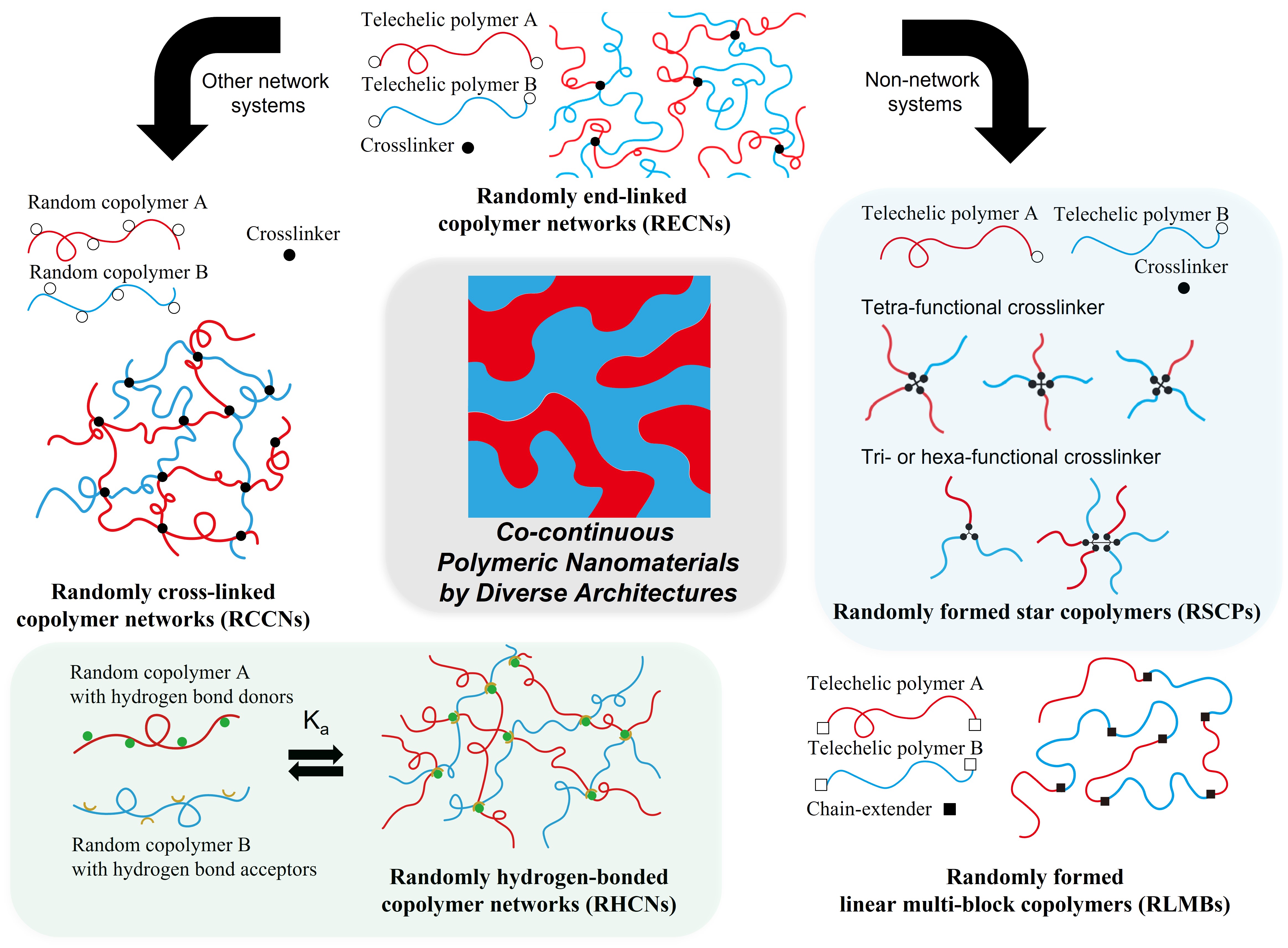2022 Annual Meeting
(2gx) Co-Continuous Polymeric Nanostructures By Microphase Separation of Diverse Molecular Architectures
Material structures and properties are deeply inter-related. Blocky copolymer systems are well-studied as tools to form a diverse array of nanostructured morphologies such as lamellae, cylinders, and spheres. Out of them, co-continuous polymeric nanostructures (CPNs), such as the double gyroid phase, draw attention due to their special features. In particular, distinct properties arising from the two phases can be achieved along all three dimensions in a single material. Despite such synergistic effects, the formation of CPNs often requires satisfying stringent requirements. For example, di-block copolymers form gyroidal nanostructures in equilibrium but only at certain ranges of composition, typically less than 5 vol. % in width. Alternatively, kinetically-trapped morphologies extend the range of accessibility of CPNs, but their sensitivity to processing conditions hampers the development of CPNs in a robust way. The need for robust systems for CPNs spurred our motivation to study blocky systems with inherent architectural dispersity.
To address this, our group found that randomly end-linked copolymer networks (RECNs) formed by end-linking telechelic polystyrene (PS) and polylactic acid (PLA) with tetra-functional crosslinkers provided a wide co-continuous boundary (30-45 wt.%). This finding motivated the following questions: (1) are network architectures essential for such a wide co-continuous window, or can other disperse copolymer architectures provide facile access to CPNs? (2) can supramolecular blocky networks also form CPNs in a robust way?
To answer these questions, non-network blocky copolymer architectures and supramolecular bonded copolymer networks have been studied. First, randomly-formed star copolymers have been investigated as a non-network architecture, following our previous random linear multi-blocks, to elucidate the roles of dispersity in preferred curvature in promoting formation of CPNs. Randomly-formed 3-arm, 4-arm, and 6-arm star copolymers were synthesized with mono-azido end-functionalized PS and PLA, and multifunctional-alkyne crosslinkers via copper-catalyzed azide-alkyne cycloaddition coupling, and compared. All of them showed much wider co-continuous regimes than the di-block (⤠5 vol. %). Interestingly, the 4-arms showed a wider co-continuous window (~30 wt.%) than those of 3-arms and 6-arms (⤠~20 wt.%) and these differences are being actively investigated.
Secondly, randomly hydrogen-bonded copolymer networks (RHCNs) were scrutinized in terms of not only inducing co-continuity but also tuning the degree of phase separation according to hydrogen bonding affinity. Random copolymer PS with phenol (Ph) in pendant, P(S-r-Ph), and polydimethylsiloxane (PDMS) with pyridine (Py) in pendant, P(DMS-r-Py), were synthesized. Their RHCNs were formed by phenol-Pyridine (Ph-Py) complexes, displaying macrophase- and microphase-separated morphologies with different numbers of Ph-Py. Further, their microphase separated structures were proven co-continuous, due to random position of Ph and Py per strand, presenting thermally responsive behaviors such as increasing domain spacing with increasing temperature. This study offers paths in forming CPNs with secondary bonds like thermally-responsive CPNs with hydrogen bonds.
Briefly introducing other examined systems, randomly cross-linked copolymer networks (RCCNs) were formed by crosslinking P(S-r-AMA) and P(2VP-r-AMA) with multi-functional crosslinkers (tri-, tetra-, and hexa-thiol) where AMA and 2VP represent allyl methacrylate and 2-vinylpyridine, showing a 35 wt.% co-continuous window. This RCCN route circumvents the RECN requirement of using telechelic polymers that usually requires anionic polymerization. The synthesis of telechelic polymers with end-group fidelity by (controlled) radical polymerization, such as atom transfer radical polymerization (ATRP) and reversible-addition fragmentation chain-transfer (RAFT) polymerization, still remains hard due to undesired side reactions such as elimination in ATRP and inherent mechanism such as fragmentation in RAFT. In contrast, crosslinkable polymer chains are easily synthesized by (controlled) radical copolymerization. Also, a new RECN with better modulus and toughness than the existing PS/PLA RECN has been developed by utilizing an engineering polymer, polysulfone, with PLA. In addition, RECNs with salt are being currently investigated for CPNs and practical applications. Building on the previous RECN system, the effects of applying different copolymer architectures and supramolecular bonding have been examined to diversify CPN accessibility and potentially cross-discipline applications.
